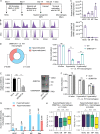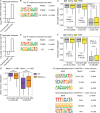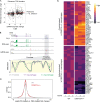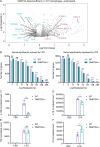DNMT3A haploinsufficiency causes dichotomous DNA methylation defects at enhancers in mature human immune cells
- PMID: 33970190
- PMCID: PMC8111463
- DOI: 10.1084/jem.20202733
DNMT3A haploinsufficiency causes dichotomous DNA methylation defects at enhancers in mature human immune cells
Abstract
DNMT3A encodes an enzyme that carries out de novo DNA methylation, which is essential for the acquisition of cellular identity and specialized functions during cellular differentiation. DNMT3A is the most frequently mutated gene in age-related clonal hematopoiesis. As such, mature immune cells harboring DNMT3A mutations can be readily detected in elderly persons. Most DNMT3A mutations associated with clonal hematopoiesis are heterozygous and predicted to cause loss of function, indicating that haploinsufficiency is the predominant pathogenic mechanism. Yet, the impact of DNMT3A haploinsufficiency on the function of mature immune cells is poorly understood. Here, we demonstrate that DNMT3A haploinsufficiency impairs the gain of DNA methylation at decommissioned enhancers, while simultaneously and unexpectedly impairing DNA demethylation of newly activated enhancers in mature human myeloid cells. The DNA methylation defects alter the activity of affected enhancers, leading to abnormal gene expression and impaired immune response. These findings provide insights into the mechanism of immune dysfunction associated with clonal hematopoiesis and acquired DNMT3A mutations.
© 2021 Lim et al.
Conflict of interest statement
Disclosures: D.C. Fajgenbaum reported grants from EUSA Pharma and non-financial support from Pfizer outside the submitted work; in addition, D.C. Fajgenbaum had a patent for "Methods of Treating Idiopathic Multicentric Castleman Disease with JAK1/2 inhibition" pending (no licensee) and a patent for "Treatment of Castleman Disease" pending (no licensee). No other disclosures were reported.
Figures













Similar articles
-
Haploinsufficiency for DNA methyltransferase 3A predisposes hematopoietic cells to myeloid malignancies.J Clin Invest. 2017 Oct 2;127(10):3657-3674. doi: 10.1172/JCI93041. Epub 2017 Sep 5. J Clin Invest. 2017. PMID: 28872462 Free PMC article.
-
Gain-of-function DNMT3A mutations cause microcephalic dwarfism and hypermethylation of Polycomb-regulated regions.Nat Genet. 2019 Jan;51(1):96-105. doi: 10.1038/s41588-018-0274-x. Epub 2018 Nov 26. Nat Genet. 2019. PMID: 30478443 Free PMC article.
-
Hematopoietic differentiation persists in human iPSCs defective in de novo DNA methylation.BMC Biol. 2022 Jun 15;20(1):141. doi: 10.1186/s12915-022-01343-x. BMC Biol. 2022. PMID: 35705990 Free PMC article.
-
[Functional role of DNMT3A mutation in acute myeloid leukemia].Rinsho Ketsueki. 2018;59(5):602-610. doi: 10.11406/rinketsu.59.602. Rinsho Ketsueki. 2018. PMID: 29877252 Review. Japanese.
-
Alterations to DNMT3A in Hematologic Malignancies.Cancer Res. 2021 Jan 15;81(2):254-263. doi: 10.1158/0008-5472.CAN-20-3033. Epub 2020 Oct 21. Cancer Res. 2021. PMID: 33087320 Free PMC article. Review.
Cited by
-
Enhancers associated with unstable RNAs are rare in plants.Nat Plants. 2024 Aug;10(8):1246-1257. doi: 10.1038/s41477-024-01741-9. Epub 2024 Jul 30. Nat Plants. 2024. PMID: 39080503 Free PMC article.
-
Nascent transcription reveals regulatory changes in extremophile fishes inhabiting hydrogen sulfide-rich environments.Proc Biol Sci. 2024 Jun;291(2025):20240412. doi: 10.1098/rspb.2024.0412. Epub 2024 Jun 19. Proc Biol Sci. 2024. PMID: 38889788 Free PMC article.
-
Successful azacitidine therapy for myelodysplastic syndrome associated with VEXAS syndrome.Int J Hematol. 2023 Jun;117(6):919-924. doi: 10.1007/s12185-023-03532-y. Epub 2023 Jan 14. Int J Hematol. 2023. PMID: 36641501
-
DNMT3A Harboring Leukemia-Associated Mutations Directs Sensitivity to DNA Damage at Replication Forks.Clin Cancer Res. 2022 Feb 15;28(4):756-769. doi: 10.1158/1078-0432.CCR-21-2863. Clin Cancer Res. 2022. PMID: 34716195 Free PMC article.
-
Constitutive loss of DNMT3A causes morbid obesity through misregulation of adipogenesis.Elife. 2022 May 30;11:e72359. doi: 10.7554/eLife.72359. Elife. 2022. PMID: 35635747 Free PMC article.
References
-
- Aryee, M.J., Jaffe A.E., Corrada-Bravo H., Ladd-Acosta C., Feinberg A.P., Hansen K.D., and Irizarry R.A.. 2014. Minfi: a flexible and comprehensive Bioconductor package for the analysis of Infinium DNA methylation microarrays. Bioinformatics. 30:1363–1369. 10.1093/bioinformatics/btu049 - DOI - PMC - PubMed
-
- Baker, T.S., Gambino K.J., Schriefer L., Lim J.Y., Steinberg K.M., Fajgenbaum D.C., Martín García-Sancho A., and Byun M.. 2018. A novel FAS mutation with variable expressivity in a family with unicentric and idiopathic multicentric Castleman disease. Blood Adv. 2:2959–2963. 10.1182/bloodadvances.2018023911 - DOI - PMC - PubMed
-
- Bock, C., Kiskinis E., Verstappen G., Gu H., Boulting G., Smith Z.D., Ziller M., Croft G.F., Amoroso M.W., Oakley D.H., et al. . 2011. Reference Maps of human ES and iPS cell variation enable high-throughput characterization of pluripotent cell lines. Cell. 144:439–452. 10.1016/j.cell.2010.12.032 - DOI - PMC - PubMed
Publication types
MeSH terms
Substances
Grants and funding
LinkOut - more resources
Full Text Sources
Other Literature Sources
Medical
Molecular Biology Databases
Research Materials

